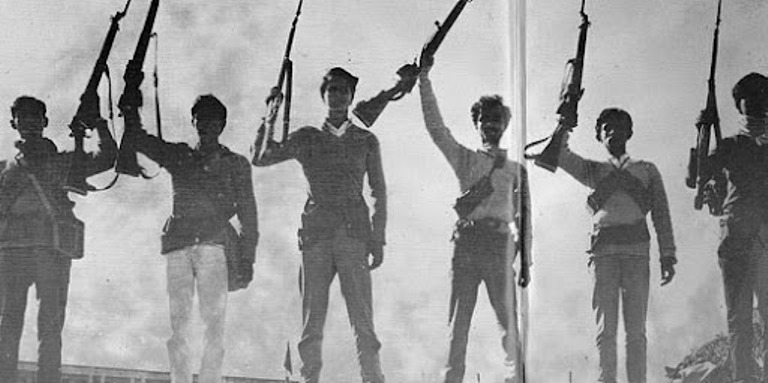
Bijoyphool: A symbol of our struggle, victory
Selim Jahan
Published:02 Dec 2021, 10:50 AM

Bijoyphool: A symbol of our struggle, victory
It was a bright sunny morning in Vientiane, where I was visiting during the first week of December 2017. As I entered the beautiful spacious French building, the Office of the Vice Premier of Laos PDR, to pay him a visit, I was proudly wearing a Bijoyphool (victory flower) as one of its Global Ambassadors. The flower beamed on the left lapel of my jacket. In fact, I was also carrying a Bijoyphool in my pocket to give it to the vice premier as a present. Soon I was received by the vice premier himself, a person of medium height, but with a pair of inquisitive eyes. After we exchanged pleasantries, the first thing he asked as he pointed to the flower on my jacket lapel was, "What is that"?
His question gave me the opportunity to explain to him the significance of the Bijoyphool. When I finished, I politely asked him whether I could pin a flower on him. His warm response was, "It would be an honour". As I was pinning it on the left side of his jacket, I was overcome with mixed feelings. I was very humbled but felt proud that I had this unique opportunity to present to a leader of a country something which is reflective of Bangladesh, its Liberation War and our ultimate and glorious victory. At the same time, I became emotional remembering the sacrifices made by millions of people of my country.
In my role as a Bijoyphool Ambassador, I have been spreading the message of this symbolic flower to groups of people in different countries; following the instructions on its website (http://www.bijoyphool.co.uk). I myself made Bijoyphools and pinned them on friends, colleagues and peers. In Vientiane, I did the same to the members of the High-Level Consultative Panel on the 2018 Human Development Report. The panel included, among others, the former finance and planning minister of Pakistan, the former governor of the Central Bank Nepal (now minister of finance) and the advisor on Science and Technology in Malaysia. Every year, from the first day of every December till the 16th—Victory Day—people wear it on their dress over their heart.
The notion of the Bijoyphool was originally conceived in London, following the idea of the poppy flower in Britain. Thus, the conceptual framework of the Bijoyphool—not a real, but an abstract flower—is broader and deeper. Three things are crucial with regard to the Bijoyphool. First, it symbolises the Liberation War of Bangladesh, its ultimate victory and independence. Second, the Bijoyphool also represents remembrance—through this symbolic flower, we remember our heroic freedom fighters, their contributions and supreme sacrifices. In a way, each one of our Muktijoddhas (freedom fighters)is a Bijoyphool too. Third, it is not only a symbol, but also an instrument. Using this flower, we can talk about our country, its history, our culture and heritage. Through it, we can take our future generations to their roots.
Today, it may serve another purpose. Bangladesh was established on the basis of four fundamental principles—nationalism, democracy, socialism in the sense of social justice, and secularism. Over the years, for various reasons, the country has moved away from its four founding principles. We have also forgotten that people's emancipation is larger than political independence. That is why Bangabandhu Sheikh Mujibur Rahman, the Father of the Nation, finished his historic March 7 speech by saying: "This struggle is a struggle for our emancipation, this struggle is a struggle for independence." Political independence is a necessary condition for people's emancipation, but on its own, it is not sufficient.
Using the Bijoyphool, we may say that out of the five petals of it, four may represent the four forgotten fundamental founding principles of Bangladesh, and the fifth petal may represent our political independence. And the red sun in the middle may reflect our yet to be achieved emancipation for our people. Such interpretation of the Bijoyphool may remind us of the path that Bangladesh set for itself in 1971.
One wonders as to why a group of people living abroad became so excited for and committed to the idea of the Bijoyphool. I can think of at least three reasons—first, each of these people have been carrying a piece of Bangladesh in their hearts. So, irrespective of time and place, they try to disseminate that piece among other compatriots all around. Second, many of them are from the 1971 generation, and they rightly refer to themselves as the children of 1971. Thus, they always want people to not forget our Liberation War heroes and to give them proper recognition and due honour. Third, they want the spirit and the history of our Liberation War to remain intact from generation to generation. They are active in ensuring that our children and their children living abroad do not forget their roots.
I, as one of the Bijoyphool Ambassadors, feel proud to be a part of the Bijoyphool journey. It is a uniquely gratifying experience. I also feel fortunate that I belong to an enviable group of peers—e.g. Urmee Mazhar in the United Kingdom, Mahfuz and Shaheen Anam in Bangladesh. As we move forward, let us not forget three things. First, the Bijoyphool journey is not a sprint, but a marathon; it is not a splash, but a continuum. Second, if each one of us, and all of us become a part of this journey, it would become a strong social movement, now needed desperately as the forces against our independence are actively conspiring against our patriotic ideals. Third, when we reach the finish line of the journey through our collective efforts, we shall realise that we have achieved what we stood and fought for. Let us not forget that more than four decades ago, "we were fighting to save a flower". Weren't we?
*Selim Jahan is former Director, Human Development Report Office and Poverty Division, UNDP